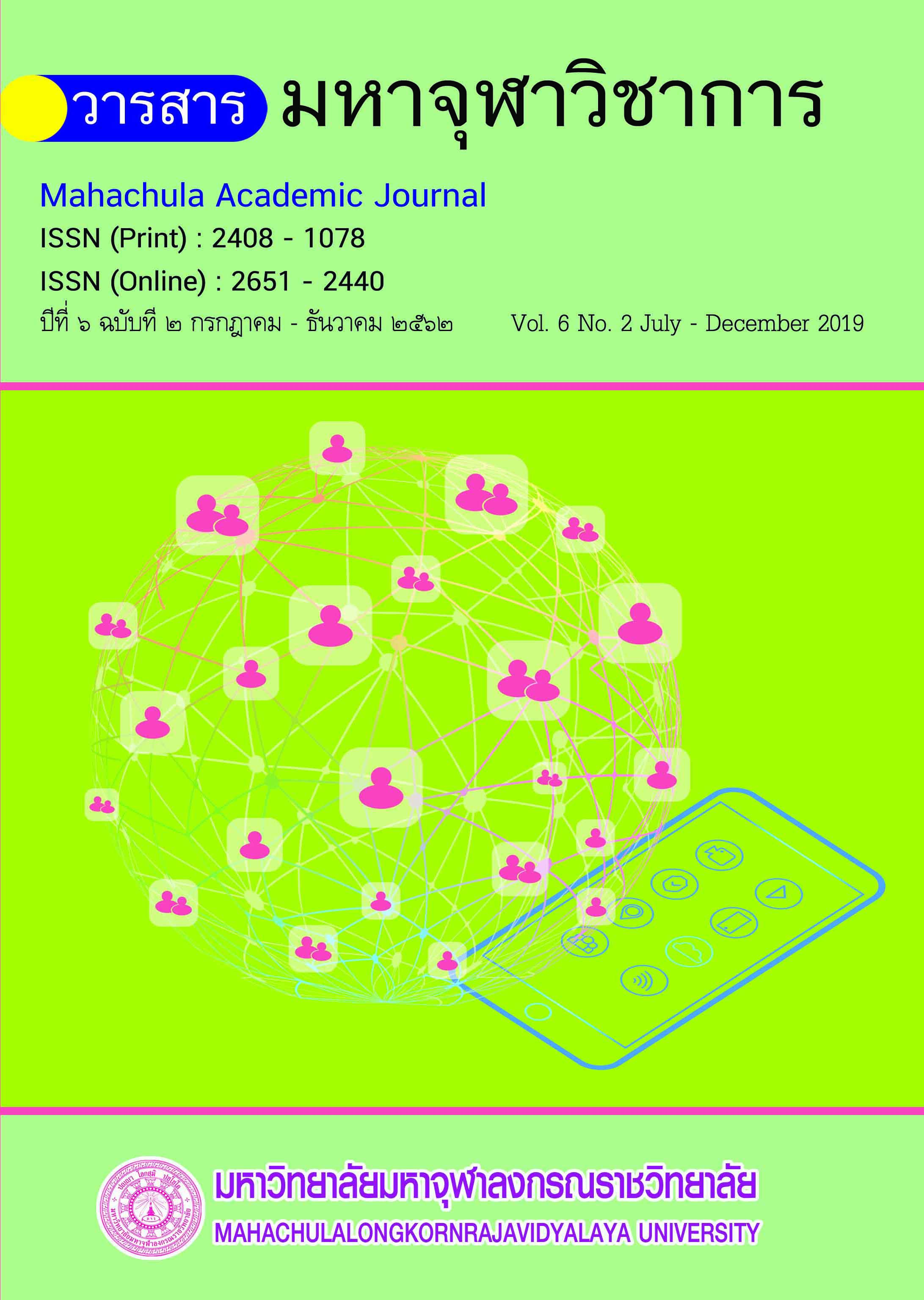The Model of School Administrative using Information and Communication Technology for Secondary School in21st Century
Main Article Content
Abstract
The purpose of this study was to develop the model of school administrative using information and communication technology for secondary school in 21st century with the following objectives: 1) to survey and synthesize the component of school administrative using information and communication technology for secondary school in 21st century, 2) to create and examine the model of school administrative using information and communication technology for secondary school in 21st century and 3) to evaluate the model and guide of school administrative using information and communication technology for secondary school in 21st century. The research was employed in three stages, namely survey and synthesize the component of school administrative using information and communication technology for secondary school in 21st century, create and examine the model of school administrative using information and communication technology for secondary school in 21st century and evaluate the model and guide of school administrative using information and communication technology for secondary school in 21st century.
The results showed that 1)Components of the school management by using information and communication technology of secondary school in the 21st century consists of 9 components: 1.1) ICT Infrastructure and Resources 1.2) Leadership 1.3) ICT strategic planning 1.4) Create a culture of ICT 1.5) Encourage teachers to use ICT, Improve ICT competency and join ICT learning community 1.6) Encourage students to use ICT, Improve ICT competency and join ICT learning community 1.7) Create a network of joint development of ICT 1.8) Monitoring and evaluate of ICT 1.9) ICT learning community and competency expertise in ICT of students, teachers, administrators, and ICT learning community networks. 2) The Model of School Administrative using Information and Communication Technology for Secondary School in 21st Century consists of four main components: 2.1) Input 2.2) Process 2.3) Output 2.4) Feedback, and the result of examination of the model found that it was high quality in terms of feasibility, utility, propriety and accuracy. 3) The result of evaluation of the model found that it was high quality in terms of feasibility, utility, propriety and accuracy.
Article Details
References
กระทรวงดิจิทัลเพื่อเศรษฐกิจและสังคม. แผนพัฒนาดิจิทัลเพื่อเศรษฐกิจและสังคม. กรุงเทพมหานคร : ผู้แต่ง, ๒๕๕๙.
กระทรวงศึกษาธิการ. ประกาศกระทรวงศึกษาธิการ เรื่อง นโยบายและมาตรฐานการพัฒนาเทคโนโลยีสารสนเทศและการสื่อสารเพื่อการศึกษา. (๒๕๕๐, ๑ พฤษภาคม).
กิติศักดิ์ พลอยพานิชเจริญ. TQM การบริหารเพื่อคุณภาพโดยรวม. กรุงเทพมหานคร : สำนักพิมพ์ ส.ส.ท. สมาคมส่งเสริมเทคโนโลยี (ไทย-ญี่ปุ่น), ๒๕๕๗.
ครรชิต จามรมาน. “การศึกษาวิเคราะห์นโยบายเทคโนโลยีสารสนเทศและการสื่อสารและการนำนโยบายสู่การปฏิบัติของโรงเรียนมัธยมศึกษาในประเทศไทย”. ปริญญานิพนธ์ครุศาสตรดุษฎีบัณฑิต. บริหารการศึกษา : จุฬาลงกรณ์มหาวิทยาลัย, ๒๕๕๓.
จันทรานี สงวนนาม. ทฤษฎีและแนวปฏิบัติในการบริหารสถานศึกษา. นนทบุรี : โรงพิมพ์บุ๊คพอยท์, ๒๕๕๓.
ทินกร พูลพุฒ. “การพัฒนารูปแบบการบริหารเทคโนโลยีสารสนเทศและการสื่อสารของสำนักงานเขตพื้นที่การศึกษาเพื่อพัฒนาการศึกษาของโรงเรียนขนาดเล็ก”. ปริญญานิพนธ์การศึกษาดุษฎีบัณฑิต. บริหารการศึกษา : มหาวิทยาลัยนเรศวร, ๒๕๕๒.
ทีปพิพัฒน์ สันตะวัน. “รูปแบบการบริหารเพื่อพัฒนาจริยธรรมของนักศึกษามหาวิทยาลัยราชภัฏภาคเหนือตอนล่าง”. ปริญญานิพนธ์การศึกษาดุษฎีบัณฑิต. บริหารการศึกษา : มหาวิทยาลัยนเรศวร, ๒๕๕๑.
เพ็ญวรา ชูประวัติ. “การพัฒนากลยุทธ์การบริหารเทคโนโลยีสารสนเทศและการสื่อสารเพื่อการศึกษาในโรงเรียนสังกัดสำนักงานเขตพื้นที่การศึกษา กรุงเทพมหานคร”. ปริญญานิพนธ์ครุศาสตรดุษฎีบัณฑิต. บริหารการศึกษา : จุฬาลงกรณ์มหาวิทยาลัย, ๒๕๕๓.
มนัสวี ศรีนนท์. “วิเคราะห์การบริหารการศึกษาไทยในศตวรรษที่ ๒๑ ด้วยทฤษฎีการบริหารการศึกษาเชิงระบบ”. วารสารศึกษาศาสตร์ มมร. ปีที่ ๓ ฉบับที่ ๒ (กรกฎาคม - ธันวาคม ๒๕๕๘) : ๕๑-๕๗.
สมคิด บางโม. องค์การและการจัดการ. พิมพ์ครั้งที่ ๗. กรุงเทพมหานคร : วิทยพัฒน์, ๒๕๕๘.
สายทิตย์ ยะฟู. “การพัฒนารูปแบบการประเมินหน่วยประเมินภายนอกระดับการศึกษาขั้นพื้นฐาน”. ปริญญานิพนธ์ปรัชญาดุษฎีบัณฑิต. สาขาวิชาวิจัยและประเมินผลการศึกษา : มหาวิทยาลัยนเรศวร, ๒๕๕๖.
สำนักงานปลัดกระทรวงศึกษาธิการ. แผนแม่บทเทคโนโลยีสารสนเทศและการสื่อสาร เพื่อการศึกษา กระทรวงศึกษาธิการ พ.ศ. ๒๕๕๔ – ๒๕๕๖. กรุงเทพมหานคร : ผู้แต่ง, ๒๕๕๔.
สำนักงานปลัดกระทรวงศึกษาธิการ. รายงานผลการศึกษาตัวชี้วัด ICT ด้านการศึกษาในสถานศึกษาระดับการศึกษาขั้นพื้นฐาน กระทรวงศึกษาธิการปีการศึกษา ๒๕๕๗. กรุงเทพมหานคร : ผู้แต่ง, ๒๕๕๗.
Mohammed, Ahmad, and Husaina, “Smart Principals and Smart Schools”, Procedia - Social and Behavioral Sciences, vol. 103, (2013) : 826 – 836.
Peter F. Drucker. Management Challenges for the 21st Century. New York : HaperBusiness, 2001.
The Partnership for 21st Century Learning (P21), “Framework Definitions P21 Framework Definitions,” <http://www.p21.org/our-work/p21-framework>, May 2015.
The United Nations Educational, Scientific and Cultural Organization(UNESCO). A Model for Obtaining ICT indicators in Education. France : UNESCO, 2016.


